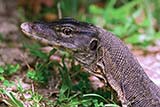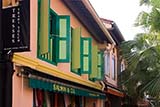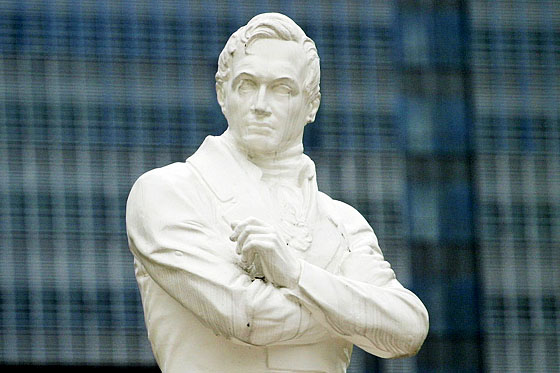Singapore History
Introduction
With the British Empire doing more trade in China in the early 19th Century, Britain was looking for a new location in which to set up a trading post. Singapore, at the bottom of the Malay Peninsula and Straits of Malacca, was ideally located for travelling between India and Southeast Asia (and beyond). On 29 January 1819 Sir Stamford Raffles and William Farquhar landed in Singapore to set up this trading post and claim the island for the British. Singapore, Malacca and Penang formed the British owned Straits Settlements. In 1867 Singapore became a Crown Colony run from London.
The second half of the 19th Century and the beginning of the 20th Century saw huge expansion of trade in Singapore. With the advent of faster steam powered ships and the opening of the Suez Canal more international trade was carried out and Singapore became an important port. It was the main port for rubber trading, an important commodity for the region. Immigrants arrived in increasing numbers from China, India, Malaya and Europe to take advantage of the island's prosperity. The majority of the population was Chinese by a considerable margin, just as it is today.
The island ran fairly smoothly under British rule until the outbreak of World War 2. On 8 December 1941 Singapore fell to the Japanese who were allowed easy access to northern Malaya via Thailand and made their way down through Malaya. Singapore fell easily which was a major shock to the Allied forces who felt that it could never happen but obviously some major tactical errors were made. The defeat was described by Churchill as the "worst defeat and largest capitulation in British history". The arguments as to whether the defeat was down to Churchill and his lieutenants in Whitehall or Arthur Percival, General Officer Commanding (GOC) Malaya, rage to this day.
In September 1945 the British returned and governed Singapore under a post-war Military Administration for six months. In 1946 Singapore went back to being a Crown Colony while Penang and Malacca went back into Malaya.
 The post-war years saw a lot of communist insurgency and a state of emergency was declared in Malaya in 1948 which lasted for 12 years. In 1953 the British set up a commission to explore a greater degree of self-government in Singapore. A Chief Minister, David Marshall, was appointed in 1955 but with only limited powers to govern the island. He resigned the following year when talks to obtain full self-government broke down. His successor, Lim Yew Hock, went to London in 1957 to continue talks and in 1958 the Constitutional Agreement was signed in London. Full self-government in Singapore became a reality in 1959.
The post-war years saw a lot of communist insurgency and a state of emergency was declared in Malaya in 1948 which lasted for 12 years. In 1953 the British set up a commission to explore a greater degree of self-government in Singapore. A Chief Minister, David Marshall, was appointed in 1955 but with only limited powers to govern the island. He resigned the following year when talks to obtain full self-government broke down. His successor, Lim Yew Hock, went to London in 1957 to continue talks and in 1958 the Constitutional Agreement was signed in London. Full self-government in Singapore became a reality in 1959.
The People's Action Party (PAP) came to power in 1959 with Lee Kuan Yew being sworn in as Singapore's first Prime Minister. The LKY dynasty, which continues to this day, had begun in earnest.
To effectively oppose the British rulers, the PAP had got into bed with the communists but they were uneasy bedfellows. The PAP moderates and the extreme communists had different ideals. Tensions continued to get worse until the communists broke away completely to form their own party in 1961.
It was around this time that talks began between Singapore and the Federation of Malaya to merge together, along with North Borneo, Sarawak and Brunei to create Malaysia. Brunei chose not to enter but in 1963 Malaysia was formed by the other countries.
Singapore at first saw this as being beneficial. They would still have their own local government but could leave central government matters to the Malays. Being part of the Federation they would have access to a large market in which to trade.
The reality for Singapore was that they were actually worse off. They complained that wealth distribution was unequal and they weren't getting their fair share. The bigger trade market they had hoped for did not materialise, in fact it decreased because Indonesia weren't happy with the merger and ceased trading with Singapore.
The alliance did not run smoothly. The predominant race in Singapore was Chinese and there was much resentment between them and the Malays. Tension continued to mount with race riots between the two groups starting in 1964. Rioting in the streets resulted in bloodshed and killing.
The Malays, with the help of the British, had overcome the communist insurgency problem that had been going on for many years. They saw Chinese dominated Singapore with much of its population coming from communist mainland China as being sympathetic to communist ideals and weren't keen on this aspect of Chinese culture.
On 9 August 1965 Singapore was kicked out of Malaysia by Tunku Abdul Rahman. The Tunku viewed it as a hopeless situation that wasn't going to get any better so called it a day in order to end the violence. The mood in the PAP was sombre with the now famous TV footage of LKY announcing the separation with tears in his eyes.
With its new independent status Singapore joined the United Nations in September 1965 and then became a member of the Commonwealth countries in October 1965. In August 1967 Singapore joined Malaysia, Thailand, Indonesia and the Philippines to form the Association of South East Asian Nations (ASEAN).
 Singapore continued building itself as a nation. The Economic Development Board was set up and was made responsible for attracting foreign companies to set up industry. Singapore made an effort to differentiate itself from other countries in the region by concentrating on hi-tech industries, not just relying on the availability of cheap labour. The Housing and Development Board (HDB) was set up to build affordable housing for Singapore's growing population. High quality education and medical facilities were also set up.
Singapore continued building itself as a nation. The Economic Development Board was set up and was made responsible for attracting foreign companies to set up industry. Singapore made an effort to differentiate itself from other countries in the region by concentrating on hi-tech industries, not just relying on the availability of cheap labour. The Housing and Development Board (HDB) was set up to build affordable housing for Singapore's growing population. High quality education and medical facilities were also set up.
The airport at Changi was completed in 1981 and Singapore made a big effort with its tourism industry. Singapore's location is not only convenient for shipping but also for airlines stopping over between Europe and Australasia with plenty of wealthy tourists aboard. In 1990 the Mass Rapid Transport (MRT) was opened. This was also the year that Lee Kuan Yew retired as Prime Minister but a special government position, Senior Minister, was created for him. He held this position until 2004 when his son became Prime Minister and the outgoing Prime Minister became Senior Minister. LKY is now Minister Mentor.
1990s to present. Singapore occasionally makes international headlines but normally for the wrong reasons. Its harsh punishments for major and minor crimes are seen by some as heavy-handed and have upset the human rights lobby at times. The hanging of a Filipino maid in 1995 and the much reported caning in 1994 of an American teenager, Michael Fay, for vandalism are two such examples. Nick Leeson, the London trader, who brought down Barings Bank in 1995 while working in Singapore was another story that brought publicity to Singapore for the wrong reasons.
The last major international news story I can remember concerning Singapore was the SARS epidemic that hit the region in 2003. This was around the same time as the attempted separation of conjoined Iranian twins Ladan and Laleh Bijani. The operation had been refused elsewhere but surgeons at Singapore's Raffles Hospital agreed to attempt it. They failed and the sisters died.
August 2004 and Lee Kuan Yew's first son, who has been finance minister and deputy prime minister for a long time, is now taking over as the country's Prime Minister thereby continuing the Lee family's hold on Singapore politics.
December 2005 and Nguyen Tuong Van, an Australian of Vietnamese descent has been hung in Singapore for drug smuggling. The Australians appealed for clemency, which wasn't given, and the Australian press turned him into some kind of a martyr.
If there is one country in the world where you do not try to smuggle drugs through, it is Singapore. I'm sorry but everyone knows this and anyone who still insists on trying to smuggle drugs and gets caught deserves what they get.
I wouldn't even bring antibiotics into Singapore from Thailand which my brother had asked for. They are completely legal but a lot cheaper in Thailand where they can be bought over the shelf without a prescription. I might have considered doing this elsewhere but not in Singapore.
Lee Kuan Yew stated publicly that one of his major regrets was not building a Formula 1 circuit in Singapore. Formula 1 would be perfect for Singapore's aspirations. The sport is perceived as glamourous, it would focus world attention on Singapore and it brings in lots of money. What has made the situation worse for Singapore - probably to the point of being unbearable - is watching its arch-rival Malaysia host F1 each year.
Well, it's April 2006 and Singapore can no longer stand to be excluded. It's that kiasu factor coming into play again. The FIA are increasing the number of races each year and inviting new venues to bid, of which one is Singapore. It will be a street circuit apparently.
I can guarantee that Singapore will spare absolutely no expense to make sure they become part of the F1 circus. With the new casinos opening some time in 2008 it all makes perfect sense as Singapore aspires to be the Monaco of the East.
Get The Best Deal On Your Singapore Hotel Room
Listed opposite are some suggestions for hotels in Singapore based on budget. Each link will take you to the relevant page on the Agoda website where you can see photos, read reviews, and book on-line. I use Agoda to book all of my own hotels in Thailand and the Southeast Asia region. Agoda hotel rates are usually always the lowest and I have received good customer service, therefore I am happy to recommend the company to other people.

Images of Thailand
Top End
Mid Range
Chinatown
Budget Hotels
Backpacker Accommodation

